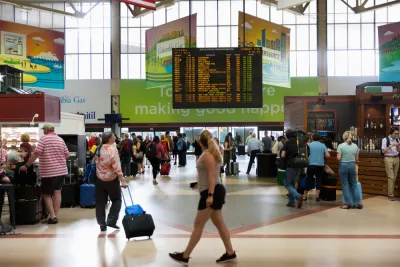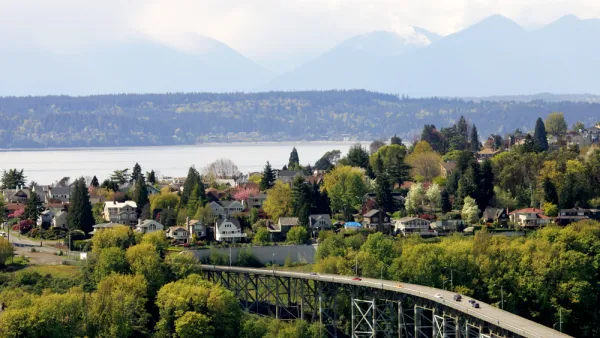A case study from the Boston region shows the power of allowing moderate density on transit adjacent residential parcels currently available only to single-family detached homes.

"[H]igh housing costs and inadequate supply are not a natural outcome of market forces; they are the result of policy choices," according to an article by Sarah Crump, Trevor Mattos, Jenny Schuetz, and Luc Schuster.
The consequences of policy choices are a disconnect between land values and land uses in the Boston region.
Land is very expensive, but the housing is mostly low-density: single-family detached homes with large yards. The Massachusetts Housing Partnership’s TODEX dataset shows that the median housing density near commuter rail stations is 2.8 homes per acre—equivalent to single-family homes on one-third acre lots. This isn’t a market outcome—it’s a sign that zoning is preventing housing markets from working.
This team of writers is presenting a new report that offers a prescription for the rising cost of housing, and resulting social ills, in Boston: loosening zoning restrictions to allow moderate-density housing near transit stations in the region, thus bringing policy and the market in closer alignment.
To allow for more housing to be built in high-demand locations, the state of Massachusetts should adopt a policy that allows moderate-density housing to be built as-of-right within a half mile of transit stations. Moderate-density housing includes duplexes, attached townhouses, and low- to mid-rise multifamily buildings.
To exemplify the affect of such a hypothetical approach to land use regulation in the state of Massachusetts, the article and the report imagines the effect of such policies on land near four commuter rail stations: Beverly Farms, Melrose Cedar Park, Needham Heights, and Wellesley Hills. The results of the experiment show decreasing home prices, and a essential first step toward solving the region's affordability problems.
FULL STORY: Fixing Greater Boston’s housing crisis starts with legalizing apartments near transit

Analysis: Cybertruck Fatality Rate Far Exceeds That of Ford Pinto
The Tesla Cybertruck was recalled seven times last year.

National Parks Layoffs Will Cause Communities to Lose Billions
Thousands of essential park workers were laid off this week, just before the busy spring break season.

Retro-silient?: America’s First “Eco-burb,” The Woodlands Turns 50
A master-planned community north of Houston offers lessons on green infrastructure and resilient design, but falls short of its founder’s lofty affordability and walkability goals.

Test News Post 1
This is a summary

Analysis: Cybertruck Fatality Rate Far Exceeds That of Ford Pinto
The Tesla Cybertruck was recalled seven times last year.

Test News Headline 46
Test for the image on the front page.
Urban Design for Planners 1: Software Tools
This six-course series explores essential urban design concepts using open source software and equips planners with the tools they need to participate fully in the urban design process.
Planning for Universal Design
Learn the tools for implementing Universal Design in planning regulations.
EMC Planning Group, Inc.
Planetizen
Planetizen
Mpact (formerly Rail~Volution)
Great Falls Development Authority, Inc.
HUDs Office of Policy Development and Research
NYU Wagner Graduate School of Public Service




























